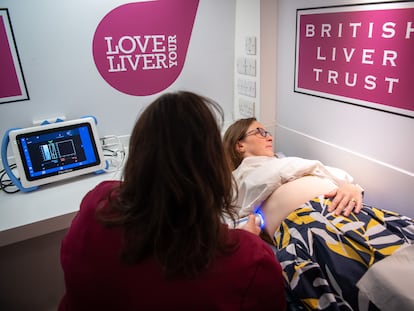A study predicts that making alcohol more expensive could reduce liver cancer cases by 5%
Since 1990, deaths from this disease in Europe have increased by 70% and those related with liver disease by 25%

More and more scientific evidence supports public health interventions through taxes on harmful products, such as tobacco, alcohol and sugary drinks. A new study, presented this week at the Congress of the European Association for the Study of the Liver (EASL), predicts that the establishment of minimum prices, combined with a tax increase, could reduce cases of liver cancer by around 5% and chronic liver disease by 7% by 2030.
The research is based on a model with data from three countries (France, the Netherlands and Romania), but according to María Buti, EASL Public Health Councillor, who invited EL PAÍS to this congress, the figures can be extrapolated to practically all of Europe, “the continent with the highest rates of alcohol consumption in the world.”
A study published in The Lancet in December 2021 estimated that 287,000 people die every year on the continent due to liver diseases, which are not only caused by alcohol, but also due to other bad nutritional habits, a sedentary lifestyle and infections, though the latter are less and less common. Since 1990, deaths from chronic liver disease have increased by 25% and from liver cancer by 70%.
A model being presented in Vienna collects epidemiological and alcohol intake data from the three countries, calculates the foreseeable drops in consumption (which have already been seen in countries like the United Kingdom) and projects their impact on liver diseases.
The researchers have tested this simulation with three tax and price models. The one that yields the best results is to impose a minimum price of one euro for each unit of alcohol, a measure used in research that is equivalent to 10 grams of pure alcohol, regardless of what drink it is served in. It would be less than what a can of beer contains. If applied, a bottle of any distillate with 40% alcoholic volume could not be sold for less than €24, nor a bottle of wine for less than seven.
Applying that measure “could reduce the number of people living with chronic liver disease or cancer by between 4% and 7% in Europe,” say the researchers. Somewhat lower results are obtained with a minimum price of €0.7 per unit of alcohol combined with a higher tax on sugary drinks, or if alcohol is taxed based on the volume of each liquor.
In the three model countries, the upper range of reductions would prevent 11,550 cases of chronic liver disease and 7,921 cases of liver cancer by 2030, compared to doing nothing. In France, it would mean public health savings of more than €600 million.
Buti explains that these types of measures work very well, especially among the population that consumes large amounts of alcohol. “In people who don’t drink much, there is no significant change, but it considerably reduces the burden of disease for those who consume more.”
Although these are projections, there is real-world experience on how pricing policy impacts alcohol consumption. Scotland and Wales attest to its effectiveness. In those countries, the minimum price policy was implemented in 2018 and 2020, respectively. In both cases, sales fell by 3.5% the year after the price increase.
“Regressive” rates
The authors acknowledge the difficulties of adding new alcohol taxes. They note that these types of rates are “inherently regressive,” since lower-income households pay a higher proportion of their income to any additional tax. “Alcohol industries often use this as an argument against implementing such policies. They claim that these taxes will have a negative impact on the poorer sections of the population and are therefore unfair. The counterargument to this, however, is that alcohol- and diet-related ill-health are also regressive and disproportionately affect lower-income populations. They are generally more prone to chronic liver disease and would therefore be positively affected by such taxation,” the report states.
The authors also take into account the obstacles that these types of measures encounter in European countries that are major producers of wine, beer and spirits and may consider these measures as an economic risk. “However, this study adds to the evidence to support the implementation of fiscal measures, including taxes, to change consumption environments over time, allowing countries to adjust in other areas,” they conclude.
Sign up for our weekly newsletter to get more English-language news coverage from EL PAÍS USA Edition
Tu suscripción se está usando en otro dispositivo
¿Quieres añadir otro usuario a tu suscripción?
Si continúas leyendo en este dispositivo, no se podrá leer en el otro.
FlechaTu suscripción se está usando en otro dispositivo y solo puedes acceder a EL PAÍS desde un dispositivo a la vez.
Si quieres compartir tu cuenta, cambia tu suscripción a la modalidad Premium, así podrás añadir otro usuario. Cada uno accederá con su propia cuenta de email, lo que os permitirá personalizar vuestra experiencia en EL PAÍS.
¿Tienes una suscripción de empresa? Accede aquí para contratar más cuentas.
En el caso de no saber quién está usando tu cuenta, te recomendamos cambiar tu contraseña aquí.
Si decides continuar compartiendo tu cuenta, este mensaje se mostrará en tu dispositivo y en el de la otra persona que está usando tu cuenta de forma indefinida, afectando a tu experiencia de lectura. Puedes consultar aquí los términos y condiciones de la suscripción digital.
More information
Archived In
Últimas noticias
Maduro pleads not guilty before the federal court in New York: ‘I am still the president of Venezuela’
A new test can detect Alzheimer’s from a finger prick
UN team enters Sudanese city of El Fasher after paramilitary massacre: ‘It’s like a ghost town’
A recipe for resistance: Indigenous peoples politicize their struggles from the kitchen
Most viewed
- Gilles Lipovetsky: ‘If you want to live better and fall in love, take Prozac, don’t look to philosophy’
- Alain Aspect, Nobel laureate in physics: ‘Einstein was so smart that he would have had to recognize quantum entanglement’
- Alvin Hellerstein, a 92-year-old judge appointed by Bill Clinton, to preside over Maduro’s trial in New York
- Maduro’s downfall puts China’s relationship with Venezuela to the test
- Why oil has been at the center of Venezuela-US conflicts for decades











































